Quickstart Guide To Inkjet Papers
By Drew Hendrix
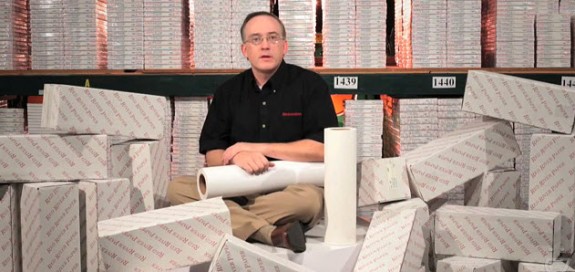
In this article, Drew Hendrix, Vice-President of Red River Paper explains inkjet paper basics that will help you select the best papers for your use. He’s shown here in Red River Paper’s huge, Dallas, Texas warehouse where hundreds of types and sizes of papers are stocked.
–Today’s selection of inkjet papers provides amazing creative opportunities for photo enthusiasts by offering quality, control and cost savings previously unknown to photographers who worked with conventional photo papers.
There are many more options to let you match the paper’s surface to suit your photographic style. Weight, texture, shade and more can finely tune the look and feel of your prints. Never in the history of photography has so much creative control been available to photographers but let’s face it, with hundreds of choices facing you, choosing the right inkjet paper can be a bit confusing.
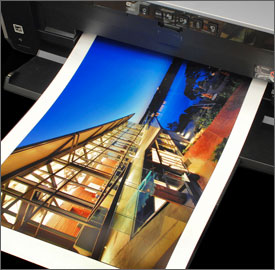
The kind of paper you use can make or break your image.
Inkjet papers are a special class of paper product. All include a base stock layer usually made from tree fiber or cotton rag content. What makes them special is a chemical coating on one or both sides. These chemicals trap ink droplets close to the paper’s surface exactly where they fall. The result is saturated color and sharp detail. The quality of this coating layer is a significant variable and not all inkjet papers are created equally. Don’t expect your office store’s ream of “coated inkjet paper” to perform at the same level as a luster paper made specifically for photo reproduction.
In the early days of inkjet photo printing there were basically two types of papers (swellable and porous) and each had to be matched to the kind of ink (dye-based or pigment) used by the printer. But today’s newly-formulated inkjet papers can produce brilliant results with both kinds of ink. These papers can be broken into five categories and knowing the different options can help you choose the best paper types for new and continuing print projects.
Photobase/Resin Coated (RC) Papers
Photobase papers offer the look and feel of the modern photo lab print. They feature a plastic (resin) base and can be coated on one or both sides. Photo labs began using RC papers in the early 1970s and the trend continues today. RC papers come in three flavors:
- Glossy – smooth reflective surface
- Luster/Satin – a lightly pebbled repeating texture
- Semi-Matte – lightly buffed glossy surface
These are the best-performing types of inkjet paper, offering the most saturation, deepest blacks, and sharpest detail.
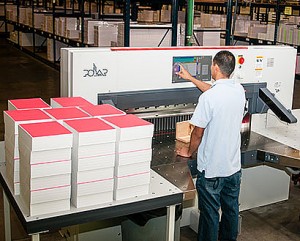
Red River Paper uses state-of-the-art equipment, such as this powerful computerized paper cutter, to assure that every sheet of paper is uniform.
Matte Photo Papers
Matte inkjet papers are typically smooth and have no gloss or reflectivity. They don’t have the “snap” of glossier papers but they are capable of high quality photo reproduction and good saturation. When displayed without a glass overlay, matte papers are excellent for viewing at wide angles without distracting reflections . They are available in many weights and can be coated on one or both sides.
Fine Art Papers
Inkjet fine art paper is usually made from 100% cotton rag paper that’s coated on one or both sides. The cotton rag is obtained from recycled clothing, rags and, to some degree, from raw cotton. Art papers are designed to offer an elegant look, feel, and higher perceived value. Image detail is similar to matte papers but below that of RC inkjet media. Different paper textures can be chosen to subtlety change the way the image is perceived by the viewer. Two kinds of fine art papers are widely used:
- Vellum/Hot Press – a smooth to semi-smooth surface with minimal texture
- Velvet/Cold Press – a pronounced textured surface
Baryta / Fibre Papers
In some cases you’ll find these products lumped in with fine art paper. I like to keep them in a separate class because baryta and fibre media are designed to mimic the look of air-dried darkroom prints which is unique. Sophisticated coating technology utilizing Barium Sulfate creates a lustrous, warm-white look– perfect for landscapes, portraits, and many fine art images.
Specialty Inkjet Papers
The four categories above comprise the majority of inkjet media you’ll find readily available. Since we can coat just about any flat surface, there are also a number of specialty products for your printing enjoyment.
- Canvas
- Metallic silver and gold
- Transparency
- Vellum
- Tattoo kits
- Metals
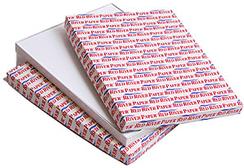 Beyond the surface type and base descriptions, technical specs will help you understand how a paper will feel and perform even before you make a purchase. Check the manufacturer’s website or look on the box to find these specs.
Beyond the surface type and base descriptions, technical specs will help you understand how a paper will feel and perform even before you make a purchase. Check the manufacturer’s website or look on the box to find these specs.
Paper Thickness
A paper’s thickness is usually described in mil or thousandths of an inch. You may also find papers measured in weight; for example, pounds or in metric specifications such as grams per square meter or gsm. But because thick papers are not always heavier than thin ones, you cannot make an exact conversion from thickness to weight. That said, here are some ranges of equivalents:
Copy paper – 5 mil (75-110 gsm)
Typical photobase RC paper – 10.5 mil (230-260 gsm)
Typical cotton fine art paper – 15 mil (310-385 gsm)
You can use these references to mentally feel a paper before even taking it out of the box.
Brightness vs. Whiteness
Brightness is a paper’s ability to reflect light while whiteness is the color quality (in a range of warm-white to cool-white) of that reflected light. The “whiter” the paper the cooler or more bluish it will be. As photographers we should be much more concerned with the whiteness (or shade) of a paper than its brightness specification. The subject of your images comes into play when considering paper shade. For instance, portraits and landscapes may benefit from a slightly warmer tone while marine and architectural shots might look best on a cooler-toned paper. Still, it’s a matter of taste so experiment with different toned papers to see how they work with various subjects.

A warmer or cooler toned paper can change the entire feeling of a print.
Optical Brighteners
Optical brightening agents (OBAs) and Fluorescent Brightening Agents (FBAs) are added to the base stock or coating to increase whiteness. On the plus side, OBAs and FBAs make paper look clean and bright with a bluer white. Despite the esthetic benefits of warmer paper for many kinds of subjects, there are customers who seek out that cool-tone, bright-white look. However, these chemicals “burn out” over time when exposed to UV light and cause the paper to return to its natural warmer shade. To avoid this issue, look for papers that are listed as “OBA Free” or “Low OBA.”
As you can see, there are many factors that go into choosing just the right paper for the effect you want; here’s how to go about it. Start with surface and thickness. Then pick a warm, neutral or cool-tone paper. Next, if you don’t want the shade to go warmer with time, avoid optical brighteners. Finally, when you find papers that work for you, stick with them. Follow these simple steps and your prints will shine.
RESOURCES
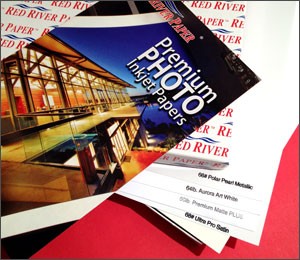
One of the best ways to become acquainted with different types of inkjet papers is to order one of Red River’s Paper Sample Kits. There are a variety of kits to choose from which will allow you to sample many different types of paper.
Original Publication Date: August 10, 2015
Article Last updated: August 10, 2015
Related Posts and Information
Categories
About Photographers
Announcements
Back to Basics
Books and Videos
Cards and Calendars
Commentary
Contests
Displaying Images
Editing for Print
Events
Favorite Photo Locations
Featured Software
Free Stuff
Handy Hardware
How-To-Do-It
Imaging
Inks and Papers
Marketing Images
Monitors
Odds and Ends
Photo Gear and Services
Photo History
Photography
Printer Reviews
Printing
Printing Project Ideas
Red River Paper
Red River Paper Pro
RRP Products
Scanners and Scanning
Success on Paper
Techniques
Techniques
Tips and Tricks
Webinars
Words from the Web
Workshops and Exhibits
all
Archives
December, 2024
November, 2024
October, 2024
September, 2024
August, 2024
July, 2024
June, 2024
May, 2024
April, 2024
more archive dates
archive article list




